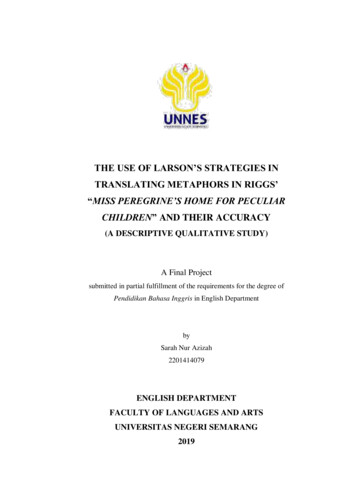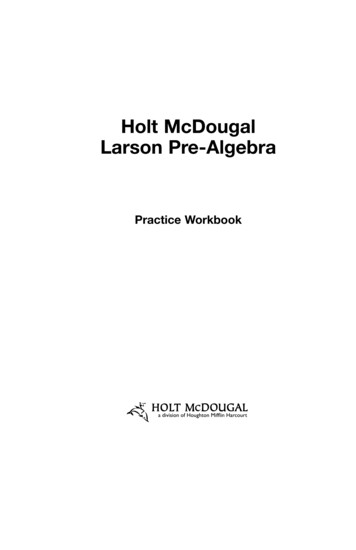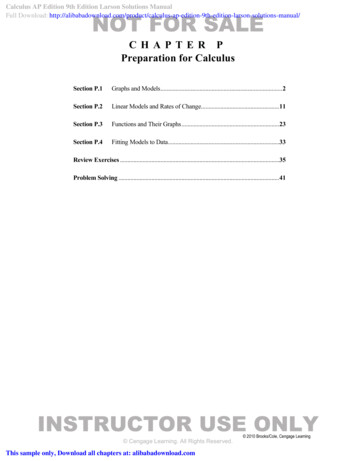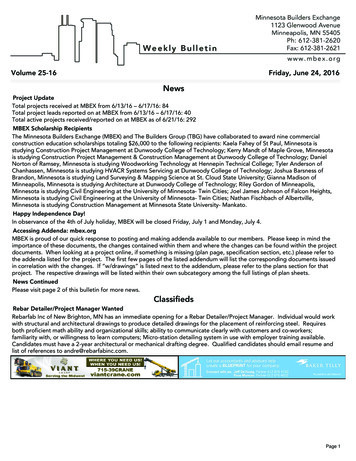
Transcription
THE USE OF LARSON’S STRATEGIES INTRANSLATING METAPHORS IN RIGGS’“MISS PEREGRINE’S HOME FOR PECULIARCHILDREN” AND THEIR ACCURACY(A DESCRIPTIVE QUALITATIVE STUDY)A Final Projectsubmitted in partial fulfillment of the requirements for the degree ofPendidikan Bahasa Inggris in English DepartmentbySarah Nur Azizah2201414079ENGLISH DEPARTMENTFACULTY OF LANGUAGES AND ARTSUNIVERSITAS NEGERI SEMARANG2019
i
ii
MOTTO AND DEDICATION“you can, you should, and if you’re brave enough to start, you will.”(Stephen King)To:My parents (Maskur Junaedi and Muhaeminatun)My brothers (Zuhdan Kamal, Amal Hudi and Najahan Bagus)My beloved Kurniawan SuryatamaMy friendsiii
ACKNOWLEDGEMENTThroughout the writing of this final project I have received a great deal ofsupport and assistance. I would like to express my gratitude to my supervisor Dr.Issy Yuliasri, M.Pd. for the useful comments, remarks and engagement throughthe learning process of this final project. In addition, I would like to thank myparents (Muhaeminatun and Maskur Junaedi) for their wise counsel andsympathetic ear and supporting me spiritually throughout my life. You are alwaysthere for me. My sincere thanks also goes to my loved ones, KurniawanSuryatama, who have supported me throughout entire process.Finally, there are my friends, who were of great support in deliberatingover our problems and findings, as well as providing happy distraction to rest mymind outside of my research.Semarang, August 20, 2019The Writeriv
ABSTRACTAzizah, Sarah Nur. 2019. The use of Larson’s Strategies in TranslatingMetaphors in Riggs’ “Miss Peregrine’s Home for Peculiar Children” and theirAccuracy. Final Project. English Department, Faculty of Languages and Arts,State University of Semarang. Advisor: Dr. Issy Yuliasri, M.Pd.Keywords: Larson, metaphor, metaphor type, metaphor translation strategy,translation accuracyThis study attempted to analyze the use of metaphor translation strategies andtheir accuracy. The objectives of the study were to describe the metaphortranslation strategies used to translate metaphors and to identify their accuracy intranslated metaphors of Riggs’ “Miss Peregrine’s Home for Peculiar Children”.This study was conducted qualitatively. Text analysis was done by comparing theoriginal and the translated novel to find out the most used metaphor translationstrategies, and rater survey was also done to find out the accuracy level of thetranslated metaphors. The results of the study showed that there were 82 data oftranslated metaphors and five metaphor translation strategies found in this study.The mostly used metaphor translation strategy was strategy 5 (the meaning of themetaphor is explained without using its metaphorical image), followed by strategy4 (the metaphor is maintained by explaining the meaning or adding the topic ofthe talk or the point of similarity), strategy 1 (the metaphor is kept in case that thereceptor language permits), strategy 2 (the metaphor is translated as simile byadding some word such as like, as, if, resemble and so on), and the last wasstrategy 3 (the metaphor of the source language is transferred to another metaphorin the target language which has the same meaning). In terms of accuracy, threeraters found that around 84.96% data were translated accurately, 14.63% datawere translated less accurately, and 0.41% data were translated inaccurately. Thetranslation strategy that contributes to highest accuracy was strategy 4.v
TABLE OF CONTENTSAPPROVAL . iDECLARATION . iiMOTTO AND DEDICATION . iiiACKNOWLEDGMENT. ivABSTRACT . vTABLE OF CONTENTS . viLIST OF FIGURES . ixLIST OF TABLES . xLIST OF APPENDICES . xiCHAPTERI. INTRODUCTION . 11.1 Background of the Study . 11.2 Reasons for Choosing the Topic . 61.3 Research Questions . 71.4 Objectives of the Study . 71.5 Significances of the Study . 71.6 Scope of the Study . 81.7 Definition of Key Terminologies . 81.8 Outline of the Study . 10II. REVIEW OF RELATED LITERATURE . 112.1 Previous Studies Review . 112.2 Theoretical Review . 222.2.1 Translation . 222.2.1.1 Translation Quality Assessment . 292.2.1.2 Accuracy of Translation . 352.2.2 Figurative Language. 382.2.2.1 Metaphor . 38vi
2.2.2.2 Metaphor Linguistic Form . 432.2.2.3 Types of Metaphor . 452.2.3 Differences between Metaphor and Simile . 472.2.4 Metaphor Translation Strategies . 482.3 Theoretical Framework . 532.4 Brief Description of Miss Peregrine’s Home for Peculiar Children . 54III. RESEARCH METHODOLOGY . 563.1 Research Design. 563.2 Object of the Study . 573.3 Source of the Data . 573.4 Roles of the Researcher . 583.5 Unit of Analysis . 593.6 Procedures of Collecting the Data . 593.7 Instruments of Data Analysis . 593.8 Method of Data Analysis . 623.9 Triangulation. 62IV. FINDINGS AND DISCUSSIONS . 634.1 General Description . 634.2 Findings . 644.2.1 Larson’s Metaphor Translation Strategies. 654.2.1.1 Keeping the Metaphor as it is . 654.2.1.2 Metaphor to Simile Meaning . 674.2.1.3 Metaphor to Metaphor with Similar Meaning . 694.2.1.4 Metaphor to Metaphor with Explanation . 704.2.1.5 Metaphor Explanation without its Imagery . 734.2.2 Types of Metaphor . 754.2.2.1 Dead Metaphor . 774.2.2.2 Cliché-Metaphor. 784.2.2.3 Stock Metaphor . 79vii
4.2.2.4 Adopted Metaphor. 814.2.2.5 Recent Metaphor . 814.2.2.6 Original Metaphor . 824.2.3 Translation Accuracy . 834.2.3.1 Accurate Translation . 854.2.3.2 Less Accurate Translation . 884.2.3.3 Inaccurate Translation . 904.2.4 The Relation of Translation Strategies and Accuracy. 924.3 Discussion. 96V. CONCLUSIONS AND SUGGESTIONS . 995.1 Conclusions . 995.2 Suggestions . 100REFERENCES . 101APPENDICES . 106viii
LIST OF FIGURESFigurePage2.1 - Process of Translation . 252.2 - Larson’s Process of Translation . 272.3 - Process of Translation by Machali . 272.4- Theoretical Framework . 53ix
LIST OF TABLESTablePage2.1 - Modification of Accuracy Rating Instrument . 373.1 - Data Analysis Form . 613.2 - Data Tabulation Form . 614.1 – Larson’s Metaphor Translation Strategy Score . 644.2 – Newmark’s Type of Metaphor Score . 764.3 - Table of Accuracy Score . 844.4 - Translation Accuracy Rating Score . 854.5 - Table of Relation of Larson’s Metaphor Strategies and Accuracy. 92x
LIST OF APPENDICESAppendixPage1 - Analysis of Translation Strategies and their Types . 1072 - Recapitulation of the Accuracy . 1253 - Relation between Translation Strategies and their Acc . 1414 - Accuracy Rating Instrument. 157xi
CHAPTER IINTRODUCTIONThis chapter presents the background of the study, reasons for choosing the topic,research questions, purposes of the study, limitation of the study, the significance ofthe study, and the outline of the research.1.1Background of the StudyReading book has significant role in this globalization era. It can enable people inanother country or people with different social background to comprehend the literaryworks of certain cultures. However, there are some books which are written out ofreader’s mother tongue. Due this condition, some books are translated into differentlanguage such as English into Indonesian. Hartono (2014) said that manymiscommunications happen every day particularly on the use of English utterances inIndonesian daily-life. Since language has three main functions: expressive,informative, and vocative function (Newmark, 1988).According to Yuliasri (2016), translation process is a complicated task as itinvolves two different languages with two different systems and produces a goodtranslation product; a translator should have good translation competence. Translationcan be defined as the result of a linguistic-textual operation in which a text in onelanguage is re-contextualized in another language. Translation process not only dealswith changing one sentence into another sentence in different language but also witha sense and nuance that translator must catch in every sentence. Translation is ageneral term that refers to the removal of reflections and ideas from one sourcelanguage (SL) and target language (TL) without changing the idea or meaning of thesource language. Based on that meaning, a successful translation can convey the1
2explicit and implicit meaning of the source language into the target language as fullyand accurately as possible. Translation must have a correspondence relationship withthe source text. Bell (1991), translation is the expression in another language (ortarget language) of what has been expressed in another language (or target language)of what has been expressed in another, source language, preserving semantic andstylistic equivalences. In using translation, human can get knowledge from foreignlanguage through meaning transferred from one language into the others. Forexample is reading a novel beside their mother tongue for every country. Reading thenovel is what some people do in their leisure time. Reading a novel, in Indonesia, thereaders will not only find some novels in Indonesian version, but also in English orother languages. Translator who is responsible to the transfer of the message bind theproper meaning several obstacles to look for the appropriate meaning of the sourcetext. Any mistranslated did will only lead to a rigid translation result or even amisunderstood translation. Translator also has to notice the figurative language toavoid the misinterpretation of meaning in the translation. There may less difficulty inreading novels in Indonesian, even though the translators use figurative languages.When it comes to reading English novels, it is another story.Translating novel from one language to another language is not an easy job.“The main problem in the process of translation is about meaning which will occurwhen the process is in progress, not translation as a product” (Hatim and Munday,2004, p. 34). Gutt (1991) said a translation is a receptor language text which is similarto the text in the source language (Stolze, 2011). Therefore, the translator shouldmaster both languages which are English and Indonesian (for example) in order toproduce a good translation work. The translator should apply translation strategies inorder to overcome the problems in transferring the message in order to produce anaccurate translation product. People realize that the quality of translation productdepends on the translator. It means that if the translator does not do the translationprocess well, the quality of the translation product will decline. Therefore, a translatoris also responsible for the content of the translation product.
3Most writers, in reading a novel do not only use their daily language, but theyalso use figurative language. Ferrer (2011) said “figurative language sparks theimagination by taking words beyond their literal meaning”. Writers intend to makethe story more alive by giving more description to help the readers picturing thestory. The figurative language that is used, especially metaphor, is closely related tothe novel writer’s culture and background, so it is probably a bit harder to beunderstood. Gibbs (2008) said that writers use metaphor to broaden their linguisticand conceptual resources and to supply novel perceptivity into experiences done byhuman. Metaphor is a kind of figurative language which is comparing two thingsdirectly, it does not use the words like, as though, as, seems, and similar to. However,a metaphor says it actually is that thing.According to Newmark (1988), metaphor can be defined as an indirectcomparison between unrelated things or subjects. The point of similarity ‘may bephysical but often it is chosen for its connotations’. He discussed a number offunctions of metaphor: to define something more closely; a decoration to showresemblances; to create emotive effect; as an object of interest for media; and lastly asa ‘basic element of language where it later becomes dead or literal language’. Forhim, translation theory is mainly concerned with the serious purpose of metaphorwhich is, “to describe an entity, event or quality more comprehensively and conciselyand in a more complex way than is possible by using literal language”. He also saidmetaphor as a figurative language and it is a single or extended text in the form of acollocation or sentence and so on. It makes a comparison between two differentthings in an unclear way rather than a clear way. It cannot be translated easily usingword for word or literal translation. It also has a high difficulty in process oftranslating. Larson (1984) stated that “If a metaphor is translated by word for wordtranslation, it will raise a misunderstanding translation result. It is because in themetaphor the culture of the source text society lies behind it. The culture of the sourcetext is not merely the same with the target text” (p. 293). Larson (1984) mentionedfive ways to translate metaphor as follow: 1) The metaphor is kept if the receptor
4language permits, 2) The metaphor is translated as simile by adding some words suchas like, as if, resemble and so on, 3) The metaphor of the source language istransferred to another metaphor in the target language which has the same meaning,4) The metaphor is maintained by explaining the meaning or adding the topic of thetalk or the point of similarity, 5) The meaning of the metaphor is explained withoutusing its metaphorical image. Newmark (1988) discussed that choosing from amongthe strategies to translate metaphors is strongly contingent upon their types.According to Newmark (1988), there are 6 types of metaphor, namely: 1) deadmetaphor, 2) cliché metaphor, 3) stock metaphor, 4) adopted metaphor, 5) recentmetaphor. Metaphor translation strategies and their types will raise the possibility thatthere will be an untranslatability condition. It is because the translator will not onlyconsider the both languages used but also the both cultures appeared.To be a good translator is not easy. The translator’s identity is alsomultifaceted. A translator must have an overall and composite identity comprising theidiosyncratic things that make the translator a social unique entity, namely a personwho translates from one language into another, not only have to know meanings,strategies and procedures but also the culture itself. There isn’t true or false intranslation but the translation has to be appropriate. The identity of the translatorimmediately reveals two important aspects of the nature of this identity, namely: (1)the identity of the translator, the contingent roles the translator undertakes in specificcontexts. As said by Nida (1964),“a ‘gloss translation’ mostly typifies formal equivalence whereform and content are reproduced as faithfully as possible and thetarget language (TL) reader is able to understand as much as hecan of the custom, manner of thought” of the source language(SL) context. Contrasting with this idea, dynamic equivalencetries to relate the receptor to modes of behavior relevant withinthe context of his own culture” without insisting that he“understands the cultural patterns of the source-languagecontext. According to him problems may vary in scope
5depending on the cultural and linguistic gap between the two ormore language.” (p. 129)Misunderstanding in translation result of metaphor if it is translated by word for wordtranslation or literal translation:1. The culture of the source text society lies behind it (not the same with the targettext).2. The image used in the source text metaphor is not used in the target textmetaphor.3. The topic of metaphor is not explicitly explained.4. The point of similarity has multi-interpretations in the variety of cultures.5. The target language metaphor do not have the comparison as it has in the sourcetext.According to Larson (1984) if metaphor is translated literally or by word for wordmethod, the translation result will often contain misperception. The problem is due tothe cultural substance of the society who speak in the source language is not alwaysthe same to the culture of the target language. Thus, the miss-equivalent translationwill result to a rigid translation or the worst is that the translator will create amisconception about the text. A translator is strived for determining an exactequivalent based on the contexts surround it. A translator has to see figurativeexpressions such as metaphor, idiom and proverb in the both languages involved inorder to avoid deviation of meaning in translation.The purpose of the metaphor translation is about deep understanding in thenovel and a diving through both cultures are two significant things to be concerned.The objective of this research is to analyze what Larson’s metaphor translationstrategies are used by the translator in the Miss Peregrine’s Home for PeculiarChildren novel and the accurate of the translation result. Ransom Riggs, the writer ofMiss Peregrine’s Home for Peculiar Children also used figurative language in
6writing this novel, he used metaphors mostly. The translation experts admit that theyoften have to work extra harder when they translating texts that contain figurativeexpressions. Metaphor is one of the problems that have to be solved by the translatorsbecause they have to translate it in high level of difficulty in the process. It isimportant to not only have a deep understanding about the two languages used butalso the understanding of cultural contexts of those languages involved. Larson(1984, p. 276) gave an example in the sentence “He is a sheep”. In several culturesthis sentence has different meanings based on the its local cultural context. It can betranslated as a person who just follows without thinking or in other culture thatsentence is translated as a young fellow waiting for girls to follow him, and manymore. From the example, the metaphorical translation must be translated properly sothat the meaning will remain the same and understood by the readers in the targettext. When translating the metaphors, the translator should apply some translationstrategies to produce good translation.1.2Reasons for Choosing the TopicThe reasons for choosing the topics are stated as follows:1. The author wanted to analyze Larson’s metaphor translation strategies usedby the translator in Miss Peregrine’s Home for Peculiar Children and theiraccuracy.2. Miss Peregrine’s Home for Peculiar Children is a bilingual/multilingualnovel which in this case appears in English version as the original versionand Indonesian version as the translated version. The author wanted toknow which one was easy to understand, imagine, and feel the sense of thenovel, the original or the translated version in the perspective of Indonesianreaders.3. The author wanted to improve translators’ skill in translating a text or abook by showing the translation quality of Miss Peregrine’s Home for
7Peculiar Children novel in choosing which strategies or types best in thetranslation metaphors in the novel.1.3Research QuestionsThere are some problems that are going to be analyzed:1. What Larson’s metaphor translation strategies are used in the translation ofmetaphors in Miss Peregrine’s Home for Peculiar Children?2. How is the degree of accuracy in the translation of metaphors in MissPeregrine’s Home for Peculiar Children?1.4Objectives of the StudyThe objectives of this study are:1. To know what Larson’s metaphor translation strategies are used in thetranslation of metaphors in Miss Peregrine’s Home for Peculiar Children.2. To determine the degree of accuracy in the translation of metaphors in MissPeregrine’s Home for Peculiar Children.1.5Significances of the StudyThe significances of this study are:1. For the readers can increase knowledge and skills in metaphor translationstrategy and metaphor itself. They can obtain the message of the story ofnovel as close as possible to the author’s intention without reducing theaesthetic values from ST.2. The result of the author’s study can be used as a reference for the otherresearcher who wants to conduct similar research related to the translationstrategy in translation subject, especially in metaphor.3. For University/PT namely as a collection of reading materials, references thesame study and to enrich the research.
84. For educator, this research can be useful as a significant material fordeveloping the translation studies, especially in the translation of metaphorand maintaining the aesthetic values of a text using relevant theories byLarson.1.6Scope of the StudyThe scope of the study aims to focus the topic research in one direction. Thespecification helps the author to analyze the problem in translation deeply. Thisresearch is limited only on the analysis of the metaphorical translation in a novelentitled Miss Peregrine’s Home for Peculiar Children and its translation inIndonesian that is used as the data source of this study. The author focuses on twopoints: the analysis of Larson’s metaphor translation strategies contained in EnglishIndonesian translation of Riggs’ Miss Peregrine’s Home for Peculiar Children andwhether the translation has accurate message beside it is acceptable and readable bythe target readers.1.7Definitions of Key TerminologiesDefinitions of terminologies are important to be given in order to avoidmisinterpretation and misunderstanding.1. TranslationTranslation is an activity dealing with replacement of a text in the source textby finding the equivalence in the target text. Translation refers to written information,whereas interpretation refers to spoken information. The purpose of translation is toconvey the original tone and intent of a message, taking into account cultural andregional differences between source and target languages.2. Source Text (ST) and Target Text (TT)Source text (ST) is the text which translator is given to translate into anotherlanguage (in other words, the original text or the text you start with). Then, target text
9(TT) is the translation of the source text (in other words, the final text or the text youend up with).3. Translation Quality Assessment (TQA)TQA is type of evaluation to mean the determination of merit, worth, orsignificance of the translation result. TQA models and procedures must pass the testof validity and reliability.4. Accuracy of TranslationAccuracy is one of the most important qualities of a good translation. Anaccurate translation is one that conveys exactly the same meaning as the original, orat least it tries to get as close as possible to the intended meaning whilst beingeffective and appropriate in the target language.5. Figurative LanguageFigurative language refers to language that uses words in ways that deviatefrom their literal interpretation to achieve a more complex or powerful effect. Thisview of figurative language focuses on the use of figures of speech that play with themeaning of words, such as metaphor, simile, personification, and hyperbole. But inthis research, the author would like to focus on metaphor only.6. MetaphorLakoff (2003, p. 1) defined metaphor as a poetic linguistic expression whereone of more words for a concept are used outside of its normal conventional meaningto express a similar concept. Metaphor is the thing that can be found everywhereautomatically and becomes part of language.7. Metaphor translation strategy“Translation strategy refers to a way which is applied by the translator tosolve the problem occurred during the translation process” (Larson, 1984, p. 252).Metaphor translation strategy can also be a procedure for solving a problem faced intranslating a metaphor.
101.8Outline of the StudyThis study is divided into five chapters. The explanation of each chapter can beelaborate as follow:Chapter one introduces the background of the study, reasons for choosing thetopic, research questions, objectives of the study, significances of the study, scope ofthe study, definitions of the terminologies, and outline of the study.Chapter two covers the review of related literature, which included previousstudies review, theoretical review, theoretical framework, and brief description aboutMiss Peregrine’s Home for Peculiar Children. Previous studies review presentedsome researchers which ever been conducted related the topic of this study.
Metaphors in Riggs’ “Miss Peregrine’s Home for Peculiar Children” and their Accuracy. Final Project. English Department, Faculty of Languages and Arts, State University of Semarang. Advisor: Dr. Issy Yuliasri, M.Pd. Keywords: Larson, metaphor, metaphor










![IN THE SUPREME COURT OF T]-lE STATE OF MONTANA](/img/7/526b198c923f8.jpg)